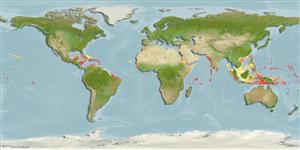>
Anguilliformes (Eels and morays) >
Muraenidae (Moray eels) > Uropterygiinae
Etymology: Channomuraena: Greek, chanos, -eos, ous, and chasma, -atos = abyss, mouth opened, inmensity + Latin, muraena = morey eel (Ref. 45335).
More on author: Richardson.
Environment: milieu / climate zone / depth range / distribution range
Écologie
marin récifal; profondeur 5 - 100 m (Ref. 5217), usually 7 - 37 m (Ref. 37816). Tropical; 24°N - 11°S
Circumtropical. Indian Ocean: Reunion and Mauritius (Ref. 33390) and Christmas Island. Western Pacific: Palau, and the Hawaiian Islands. Western Atlantic: Bermuda, Bahamas, and Caribbean Sea; may occur in southern Florida, USA and northwestern Gulf of Mexico (Ref. 7251). Reported from Bahia, Brazil (Ref. 57756). Eastern Atlantic: around oceanic islands.
Taille / Poids / Âge
Maturity: Lm ? range ? - ? cm
Max length : 150 cm TL mâle / non sexé; (Ref. 37816); common length : 80.0 cm TL mâle / non sexé; (Ref. 5217)
Épines dorsales (Total) : 0; Rayons mous dorsaux (Total) : 0; Épines anales: 0; Rayons mous anaux: 0. The small cranium, anterior position of the eyes, and enlarged lower jaw are unique (Ref 1602)
A benthic species and solitary species (Ref. 26340) inhabiting outer reef slopes. Occurs under ledges and in holes of reef slopes (Ref. 37816). Has the habit of puffing its head like a cobra when approached (Ref. 37816). Secretive and nocturnal (Ref. 48635). Minimum depth reported taken from Ref. 30874.
Life cycle and mating behavior
Maturities | Reproduction | Spawnings | Egg(s) | Fecundities | Larves
Böhlke, J.E., 1981. Muraenidae. In W. Fischer, G. Bianchi and W.B. Scott (eds.) FAO species identification sheets for fishery purposes. Eastern Central Atlantic, (Fishing Areas 34, 47 (in part)), Vol. 3. [var. pag.]. FAO, Rome. (Ref. 3254)
Statut dans la liste rouge de l'IUCN (Ref. 130435)
Menace pour l'homme
Harmless
Utilisations par l'homme
Pêcheries: pêcheries vivrières; Aquarium: Commercial
Outils
Articles particuliers
Télécharger en XML
Sources Internet
Estimates based on models
Preferred temperature (Ref.
123201): 25.5 - 28.9, mean 27.7 °C (based on 388 cells).
Phylogenetic diversity index (Ref.
82804): PD
50 = 0.7500 [Uniqueness, from 0.5 = low to 2.0 = high].
Bayesian length-weight: a=0.00069 (0.00033 - 0.00144), b=3.12 (2.93 - 3.31), in cm total length, based on LWR estimates for this (Sub)family-body shape (Ref.
93245).
Niveau trophique (Ref.
69278): 4.0 ±0.66 se; based on food items.
Résilience (Ref.
120179): Très faible, temps minimum de doublement de population supérieur à 14 ans (Preliminary K or Fecundity.).
Fishing Vulnerability (Ref.
59153): Very high vulnerability (90 of 100).
